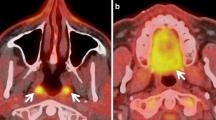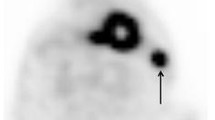Abstract
The aim of this study was to evaluate the clinical value of positron emission tomography (PET) with11C-labeled choline (CHOL) for the differential diagnosis of malignant head and neck tumors from benign lesions as compared with18F-fluorodeoxyglucose PET.Methods: We studied 45 patients (28 males, 17 females, age range, 29-84 years) with suspected lesions in the head and neck region using both CHOL and FDG PET within a 2-week period on each patient. All patients fasted for at least 6 hours for both the CHOL and FDG studies. PET imaging was performed 5 min and 50-60 min after intravenous injection of CHOL and FDG, respectively. After data acquisition, PET images were corrected for attenuation, and the reconstructed images were analyzed by visual interpretation. Then, the standardized uptake value (SUV) was calculated for semiquantitative evaluation of tumor tracer uptake. Finally the results of PET scans were compared with the histological diagnoses from surgical specimens or biopsies.Results: With CHOL PET, malignant tumors were correctly detected in 24 (96%) of 25 patients, and benign lesions in 14 (70%) of 20 patients with an accuracy of 84.4%. With FDG PET, malignancy was correctly diagnosed in 23 (92%) of 25 patients, and benign lesions in 13 (65%) of 20 patients resulting an accuracy of 80%. A significant positive correlation between CHOL and FDG SUVs was found for all lesions (r = 0.677, p = 0.004, n = 45). Malignant tumors showed significantly higher tracer accumulation than the benign lesions in both CHOL and FDG studies (5.69 ± 1.61, n = 25 vs. 2.98 ± 2.13, n = 20, p < 0.0001; 9.21 ± 4.23, n = 25 vs. 3.60 ± 2.57, n = 20, p < 0.0001). The cutoff SUV for differentiating malignant and benign lesions was 3.5 for CHOL and 3.9 for FDG. CHOL showed slightly better differentiation between malignant and benign lesions than FDG although some overlap existed on both studies. But the difference was not statistically significant.Conclusion: The results of this study indicate that CHOL PET may be feasible clinically for head and neck tumor imaging. PET imaging with CHOL seems to be able to detect malignant head and neck tumors as effectively as FDG PET. The advantages of CHOL PET were shorter examination period and low uptake in the muscle. However, both CHOL and FDG have some limitations in the evaluation of salivary gland lesions.
Similar content being viewed by others
References
Panje WR, Namon AJ, Vokes E, Haraf DJ, Weichselbaum RR. Surgical management of the head and neck cancer patient following concomitant multimodality therapy.Laryngoscope 1995; 105:97–101.
Nowak B, Di Martino E, Janicke S, Cremerius U, Adam G, Zimny M, et al. Diagnostic evaluation of malignant head and neck cancer by F-18-FDG PET compared to CT/MRI.Nuklearmedizin 1999; 38:312–3188.
Scott AM. Current status of positron emission tomography in oncology.Int Med 2001 ; 31:27–366.
Hannah A, Scott AM, Tochon-Danguy H, Chan JG, Akhurst T, Berlangieri S, et al. Evaluation of18F-fluorodeoxyglucose positron emission tomography and computed tomography with histopathologic correlation in the initial staging of head and neck cancer.Ann Surg 2002; 236:208–2177.
Gallagher BM, Fowler JS, Gutterson NI, MacGregor RR, Wan CN, Wolf AP. Metabolic trapping as a principle of radiopharmaceutical design: some factors responsible for the biodistribution of [18F] 2-deoxy-2-fiuoro-D-glucose.J Nucl Med 1978; 19:1154–11611.
Bailet JW, Abemayor E, Jabour BA, Hawkins RA, Ho C, Ward PH. Positron emission tomography: a new, precise imaging modality for detection of primary head and neck tumors and assessment of cervical adenopathy.Laryngoscope 1992; 102:281–2888.
Yasuda S, Shohtsu A, Ide M, Takagi S, Ogawa J, Mitomi T, et al. High fluorine-18 labeled deoxyglucose uptake in sarcoidosis.Clin Nucl Med 1996; 21:983–9844.
Kubota R, Yamada S, Kubota K, Ishiwata K, Tamahashi N, Ido T. Intratumoral distribution of fluorine- 18-fluoro- deoxyglucosein vivo: high accumulation in macrophages and granulation tissues studied by microautoradiography.J Nucl Med 1992; 33:1972–19800.
Braams JW, Pruim J, Freling NJ, Nikkeis PG, Roodenburg JL, Boering G, et al. Detection of lymph node metastases of squamous cell cancer of the head and neck with FDG-PET and MRI.J Nucl Med 1995; 36:211–2166.
Torizuka T, Clavo AC, Wahl RL. Effect of hyperglycemia onin vitro tumor uptake of tritiated FDG, thymidine, l- methionine and L-leucine.J Nucl Med 1997; 38:382–3866.
Hara T, Yuasa M. Automated synthesis of [11C]choline, a positron-emitting tracer for tumor imaging.Appl Radiat Isot 1999; 50:531–5333.
Roivainen A, Forsback S, Gronroos T, Lehikoinen P, Kahkonen M, Sutinen E, et al. Blood metabolism of [methyl-11C]choline, implications forin vivo imaging with positron emission tomography.Eur J Nucl Med 2000; 27:25–322.
Zeisel SH. Dietary choline: biochemistry, physiology, and pharmacology.Annu Rev Nutr 1981; 1:95–1211.
Katz-Brull R, Degani H. Kinetics of choline transport and phosphorylation in human breast cancer cells: NMR application of the zero trans method.Anticancer Res 1996; 16:1375–13800.
Miller BL, Chang L, Booth R, Ernst T, Cornford M, Nikas D, et al.In vivo 1H MRS choline: correlation within vitro chemistry/histology.Life Sci 1996; 58:1929–19355.
Wald LL, Nelson SJ, Day MR, Noworolski SE, Henry RG, Huhn SL, et al. Serial proton magnetic resonance spectroscopy imaging of glioblastoma multiforme after brachytherapy.J Neurosurg 1997; 87:525–5344.
Hara T, Kosaka N, Shinoura N, Kondo T. PET imaging of brain tumor with [methyl-11C]choline.J Nucl Med 1997; 38:842–8477.
Kobori O, Kirihara Y, Kosaka N, Hara T. Positron emission tomography of esophageal carcinoma using11C-choline and18F-fluorodeoxyglucose: a novel method of preoperative lymph node staging.Cancer 1999; 86:1638–16488.
Kotzerke J, Prang J, Neumaier B, Volkmer B, Guhlmann A, Kleinschmidt K, et al. Experience with carbon-11 choline positron emission tomography in prostate carcinoma.Eur J Nucl Med 2000; 27:1415–14199.
Hamacher K, Coenen HH, Stöcklin G. Efficient stereospecific synthesis of no-carrier-added 2[18F]-fluoro-2-deoxy-D-glucose using amino polythene supported nucleophilic substitution.J Nucl Med 1986; 27:235–2388.
Haubrich DR, Wang PF, Wedeking PW. Distribution and metabolism of intravenously administered [methyl-3H]choline and synthesisin vivo of acetylcholine in various tissues of guinea pigs.J Pharmacol Exp Ther 1975; 193:246–2555.
Pieterman RM, Que TH, Elsinga PH, Pruim J, van PuttenJW, Willemsen AT, et al. Comparison of11C-choline and18F-FDG PET in primary diagnosis and staging of patients with thoracic cancer.J Nucl Med 2002; 43:167–1722.
Kalra R, Wade KE, Hands L, Styles P, Camplejohn R, Greenall M, et al. Phosphomonoester is associated with proliferation in human breast cancer: a31P MRS study.Br J Cancer 1993; 67:1145–11533.
Leskinen-Kallio S, Ruotsalainen U, Nagren K, Teras M, Joensuu H. Uptake of carbon-11-methionine and fluoro- deoxyglucose in non-Hodgkin’s lymphoma: a PET study.J Nucl Med 1991; 32:1211–12188.
Shiga T, Tsukamoto E, Nakada K, Morita K, Kato T, Mabuchi M, et al. Comparison of18F-FDG,131I-Na, and201Tl in diagnosis of recurrent or metastatic thyroid carcinoma.J Nucl Med 2001 ; 42:414–199.
Minn H, Clavo AC, Wahl RL. Influence of hypoxia on tracer accumulation in squamous cell carcinoma:in vitro evaluation for PET imaging.Nucl MedBiol 1996; 23:941- 9466.
Hara T, Kosaka N, Suzuki T, Kudo K, Niino H. Uptake rates of18F-fluorodeoxyglucose and11C-choline in lung cancer and pulmonary tuberculosis: a positron emission tomography study.Chest 2003; 124:893–9011.
Ishidate H. Choline transport and choline kinase. In: Vance DE, ed.Phosphatidylcholine Metabolism. Boca Raton, FL; CRC Press, 1989: 9–32.
DeGrado TR, Baldwin SW, Wang S, Orr MD, Liao RP, Friedman HS, et al. Synthesis and evaluation of18F-labeled choline analogs as oncologic PET tracers.J Nucl Med 2001 ; 42:1805–18144.
Torizuka T, Kanno T, Futatsubashi M, Okada H, Yoshikawa E, Nakamura F, et al. Imaging of gynecologic tumors: comparison of11C-choline PET with18F-FDGPET. J Nucl Med 2003; 44:1051–10566.
Zhang H, Tian M, Oriuchi N, Higuchi T, Watanabe H, Aoki J, et al.11C-choline PET for the detection of bone and soft tissue tumours in comparison with FDG PET.Nucl Med Commun 2003; 24:273–2799.
Keyes JW Jr, Harkness BA, Greven KM, Williams DW 3rd, Watson NE Jr, McGuirt WF. Salivary gland tumors: pretherapy evaluation with PET.Radiology 1994; 192:99- 1022.
Khan N, Oriuchi N, Zhang H, Higuchi T, Tian M, Inoue T, et al. A comparative study of11C-choline PET and [18F]fluorodeoxyglucose PET in the evaluation of lung cancer.Nucl Med Commun 2003; 24:359–3666.
Zheng QH, Stone KL, Mock BH, Miller KD, Fei X, Liu X, et al. [11Qcholine as a potential PET marker for imaging of breast cancer athymic mice.Nucl Med Biol 2002; 29:803- 8077.
Lindholm P, Leskinen-Kallio S, Minn H, Bergman J, Haaparanta M, Lehikoinen P, et al. Comparison of fluorine- 18-fluorodeoxyglucose and carbon-11-methionine in head and neck cancer.J Nucl Med 1993 ; 34:1711–17166.
Jabour BA, Choi Y, Hoh CK, Rege SD, Soong JC, Lufkin RB, et al. Extracranial head and neck: PET imaging with 2- [F-18]fluoro-2-deoxy-D-glucose and MR imaging correlation.Radiology 1993; 186:27–355.
Hany TF, Schuknecht B, Schmid DT, Seifert B, von SchulthessGK, Goerres GW. In-line PET/CT in head and neck cancer patients: a comparison with FDG PET and contrast-enhanced CT. (Abstract)Eur J Nucl Med Mol Imaging 2003; 30:S277.
Author information
Authors and Affiliations
Rights and permissions
About this article
Cite this article
Khan, N., Oriuchi, N., Ninomiya, H. et al. Positron emission tomographic imaging with11C-choline in differential diagnosis of head and neck tumors: comparison with18F-FDG PET. Ann Nucl Med 18, 409–417 (2004). https://doi.org/10.1007/BF02984484
Received:
Accepted:
Issue Date:
DOI: https://doi.org/10.1007/BF02984484




